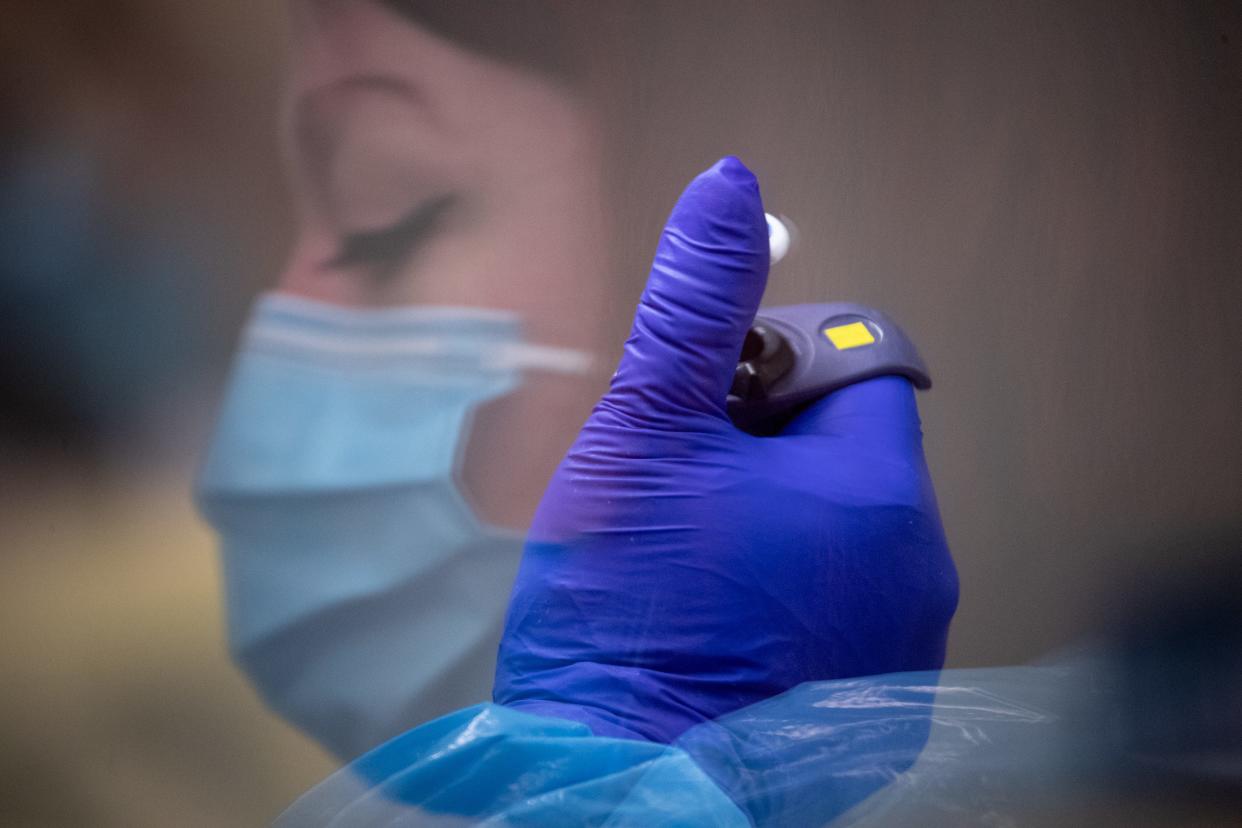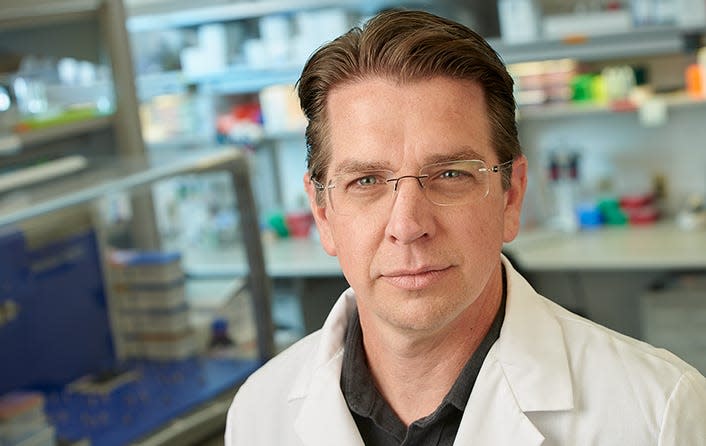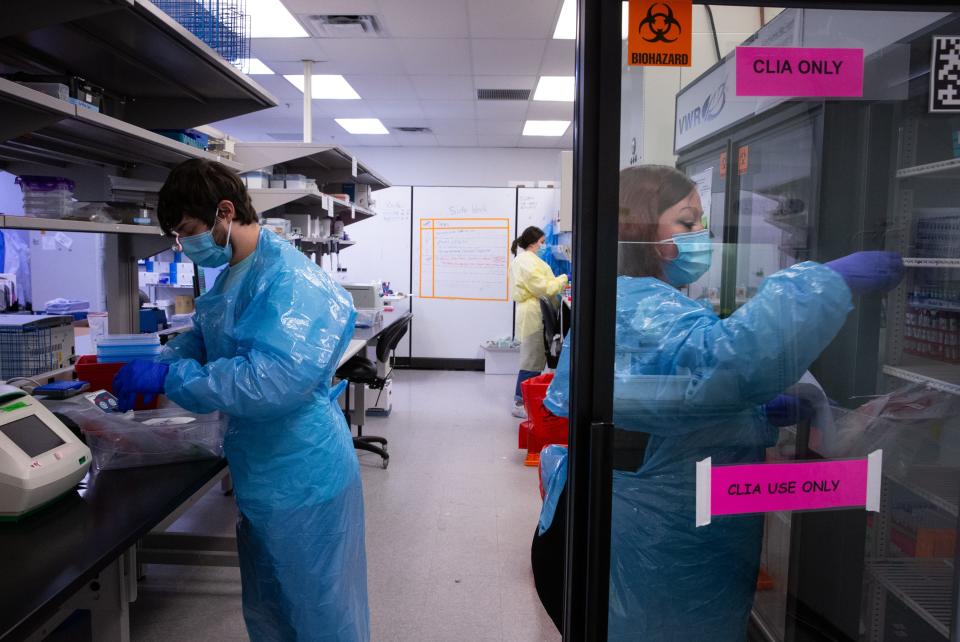Arizona scientists have mapped 100,000 coronavirus genomes, but say the work isn't done

- Oops!Something went wrong.Please try again later.
For nearly two years, researchers have used biology and computer science to trace changes in the genetic makeup of the coronavirus, the culprit behind COVID-19. Their work has enabled health officials and the general public to understand the nature of the threat posed by the virus, including characteristics of each variant, like transmissibility and risk to vulnerable populations.
Now Arizona scientists have hit a key milestone: They have sequenced over 100,000 SARS-CoV-2 genomes statewide since the start of the pandemic.
To do it, researchers at the state's three universities, the state health services department and nonprofit research institute TGen collaborated with each other and with scientists around the world to turn millions of lines of genetic code into a vast library of information about the novel coronavirus.
Their quest for that knowledge continues as they follow the circulating subvariants of omicron, the strain that emerged in November and caused surges around the world. The variety BA.2, sometimes called “stealth omicron,” has now become the dominant strain of the coronavirus in Arizona, accounting for nearly all cases sequenced.
But if researchers have learned anything from watching SARS-CoV-2 pass through communities, it’s that the virus doesn’t remain static for long.
“What's important for me as I think about this surveillance program for our state of Arizona (is that) it is my responsibility to actually be on top of all these variants,” said Efrem Lim, an assistant professor at Arizona State University’s Biodesign Institute, whose lab sequences SARS-CoV-2 genomes.
BA.2 did not initially cause a significant jump in case numbers or hospitalizations in the U.S., though overall COVID-19 case numbers have recently started to tick up nationally. Scientists like Lim say they’re also starting to see the newly evolved BA.2.12.1, a version of the virus that evolved from BA.2. It so far accounts for about 15% of cases sequenced, but doesn’t yet seem to be causing a surge in cases either (though overall statewide case counts are also creeping up, according to data from the Mayo Clinic).
Even if case numbers remain low for now, researchers say they’re watching to see if any of omicron’s evolutionary offshoots gain a competitive edge, which could affect potential future surges in a few months.
“The window of waning immunity is going to approach (sometime) in the summer,” Lim said, and the severity of a potential surge “depends on what that variant is going to look like when (immunity) comes down.”
Omicron surprised scientists worldwide because it did not evolve from the previous dominant strain, delta. For now, researchers are keeping an eye on omicron as it evolves, generating what researchers call “subvariants” rather than completely distinct new variants, which would be more genetically unique (and receive their own Greek letter).
To make the distinction, scientists analyze genetic mutations as they arise and compare them to other mutations. They can also work with labs around the country to paint a fuller picture of the virus as it smolders at low levels across populations.
It’s smoldering here, too. As BA.2.12.1 begins to show up in Arizona samples, variant trackers around the world are picking up other omicron “sister lineages.” Those include the ones dubbed BA.4 and BA.5, in addition to some cases of a hybrid called “XE,” a mixture of BA.1 (the first omicron strain to take off) and BA.2.

The work of watching changes to the virus functions as a kind of early warning system, said David Engelthaler, director of the pathogen and microbiome division at TGen.
“We can't predict exactly where or when (a significantly different variant may arise), but we can do our best to try to detect it as early as possible,” he said.
It’s a task Lim says is still urgent, even if life feels like it has returned to “normal” for many.
“If I really felt that this was something we (would) all just deal with because it's not going to be a problem, what I’d probably do is I (would) close the lab sequencing program for this and do something that I think is more important," said Lim, who studied several other viruses before the pandemic and continues to advance that research in addition to tracking the coronavirus.
But Lim’s not closing his COVID-19 sequencing lab any time soon.
“If we don't do anything to fight that new changing virus, it’s going to be a big problem again,” he said.
‘That’s what viruses do. They evolve’
Every time the coronavirus infects someone, it uses their cells like its own personal copy machine, multiplying itself so it can spread further. But unlike a copy machine, viral replication isn’t perfect. There are small, random errors in every copy.
Those errors add up, and scientists call them “mutations.” Mutations aren’t inherently good or bad; they just subtly change the structure of the virus. That sometimes makes things worse for the virus, but it also sometimes makes it easier for the virus to spread. When conditions favor a certain mutation, that’s called “selection.”
Those basic mechanisms of evolution — mutation, selection and randomness — influence the coronavirus, creating the pressures that can cause it to become more transmissible, cause more severe disease or become better able to evade the immune system, said Pavitra Roychoudhury, an acting instructor at the University of Washington who has led sequencing efforts there since the start of the pandemic.
“The more cases you have, the more opportunities you're opening up to the virus to explore genetic territory through mutations,” she said.
In the case of omicron, those mutations showing up in each subvariant don’t seem to be making a big difference in case numbers or clinical outcomes, Engelthaler said.
“It just seems like there's just little tweaks in the genome, little mutations that show up that end up becoming a (subvariant) that's more dominant than the last, but nothing is really remarkably changed about the virus,” he said.
Still, Lim is watching two notable BA.2.12.1 mutations, one because he’s seen it before, the other because it’s a mystery. The first, which scientists named L452Q, was last seen in the lambda variant, allowing that variant to more easily escape the immune system.
“We call that convergent evolution,” Lim said. “So this is something that evolved independently (for the virus) to pick up this additional mutation.”
In other words, by pure coincidence, a mutation that was useful to a previous version of the coronavirus has shown up again, and may help this subvariant surpass BA.2 in Arizona.
Lim said researchers aren’t sure what the other mutation does yet, though they suspect it has something to do with the now-infamous spike protein — the pointy bits sticking off the main sphere in illustrations, the part of the virus’ structure that helps it get into our cells. That’s a sign that the second mutation could also have something to do with immune escape, but scientists need more data to be sure.
Seeing L452Q early was important because it “gave us the head start to do the research and show that this mutation escapes the immune response,” Lim said. “The very first time we (see a) mutation, we would then need to do the experiments to show (whether it matters) for antibody responses and so forth.”
Although our ability to fight COVID-19 with vaccines, antivirals and better hospital care is improving — all of which make it easier for us to manage living with the virus — Lim said it’s a misconception that the virus is destined to become milder.
“That’s what viruses do," he said. "They evolve. However, in this case, we know it's evolving to what's (known as) an immune escape mutation, not (to) being milder in any sense.”
Arizona and the nation’s strategy on coronavirus sequencing
Keeping tabs on viral evolution using genomic techniques, beyond just testing a subset of positive PCR tests, will be critical around the world to keep the coronavirus under control, Engelthaler said.
“The virus can be circulating out there in places that we're not really doing a great job of monitoring,” he said.
That includes animal populations. Since creatures like dogs and cats can become infected just like humans can, TGen has been monitoring house pets as well as humans to try to better understand animal reservoirs. They have also partnered with the Arizona Game and Fish Department and with local zoos to start surveilling wild and exotic animals as well as domestic ones.

But closely watching animals won’t be enough. In Washington, Roychoudhury is aware of the fact that more at-home tests (and more pandemic fatigue) mean fewer samples at sequencing labs, potentially limiting how well scientists can track future variants.
“In general, testing volumes have dropped," she said. "And my worry recently has been, ‘is that going to impact our ability to find the next variant … if we're not getting enough samples for testing?’ So that has been one ongoing concern.”
The source of those samples also makes a difference, she said.
“Certain locations are overrepresented geographically,” Roychoudhury said. If the majority of samples sequenced come from certain regions, it might be easier to initially miss a variant that arises in a less-sampled area. “So, the other thing I've worried about (is) the evenness of sampling the world of COVID-19, so that you can find that next variant,” she added.
Similar patterns have played out in Arizona — sequencing labs are testing far fewer tests than they were, say, at the height of the first omicron surge, and most of the samples come from Maricopa County — but that doesn’t mean there’s no information to be gleaned from the data that does exist, according to Engelthaler.
“What we can do is certainly look at the numbers that we do have, and (though) the percentage positives have been really low, they've actually been creeping up a little bit even though the amount of testing has been dropping,” he said. “So that does mean that the virus is still out there. COVID is still a thing. It's just not an emergency right now.”
Testing labs around the country, and around the world, are tasked with helping public health officials and the general public to understand when the coronavirus does become an emergency. That’s part of a developing national strategy; the CDC announced in mid-April that it would be launching a new team called the Center for Forecasting and Outbreak Analytics, which one of its scientists described as a “National Weather Service, but for infectious diseases.”
“It is only by sequencing samples of the COVID virus — using the power of genomic
technologies — that scientists here in Arizona, and our colleagues around the world, have kept track of all the mutations and subsequent COVID variants during this pandemic,” Engelthaler said in a TGen press release. “Never before has a feat like this been accomplished for an infectious pathogen.”

Hope amidst ‘sobering’ realities
For now, scientists aren’t seeing any variants coming out of left field to take over like omicron did last fall. That would be “very highly unlikely,” said Janko Nikolich-Žugich, the head of the immunobiology department at the University of Arizona who is leading a consortium aimed at studying long COVID, the syndrome in which COVID-19 symptoms last weeks, months or even years after the initial infection.
As other scientists continue to watch variants evolve in real time, Nikolich-Žugich said he sees an intense need to advance research on long COVID. “There's increasing mobilization to study and to understand” the condition, he said.
“(It’s) sobering (to see) young healthy people that are no longer healthy and don’t know whether they will become healthy,” he added.
Engelthaler said public health officials should also continue to focus attention on groups that are at highest risk of severe disease or death, including elderly people who live in congregate care settings.
“I think that that is where, if we want to try to prevent deaths, we’ve got to work with our long term care facility community, (and) help give them the resources that they can use to best protect their residents and their patients,” he said.
For the elderly and immunocompromised, a second booster would be beneficial, he said, but an updated booster will be more valuable for the general population.
“What we do need is an updated vaccine,” he said. “Those will be ready for us hopefully later this year (in the fall or winter) — that'll be a good time to get boosted,” he said.
Lim acknowledged that it’s not easy to watch the virus evolve or to think about the accompanying public health measures that officials implement to keep pace with its changes. He still hopes to meet pandemic fatigue with empathy as well as realism.
“As scientists … We look at the data and we face the reality of an evolving virus, “ Lim said. “(But) we understand the reality that you are living with, and we get that, too. And so when we come together to then take our data and say, what's the best foot forward for public health, it cannot just be based on an intellectual decision that has no grounding in society.”
The choices adopted by public health experts and scientists going forward will shape the direction of the pandemic, he said, one that he believes doesn’t have to end in resignation to living with the coronavirus forever.
“If you truly believe that you can eradicate (SARS-CoV-2) … We have done that for several viruses before. We can do that here as well,” he said.
Independent coverage of bioscience in Arizona is supported by a grant from the Flinn Foundation.
Melina Walling is a bioscience reporter who covers COVID-19, health, technology, agriculture and the environment. You can contact her via email at mwalling@gannett.com, or on Twitter @MelinaWalling.
This article originally appeared on Arizona Republic: Arizona scientists have sequenced 100,000 SARS-CoV-2 genomes

